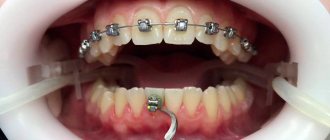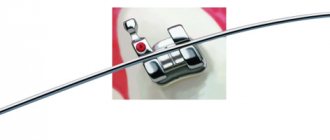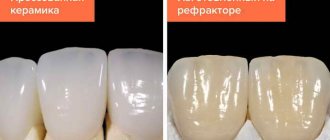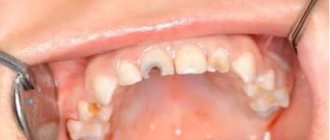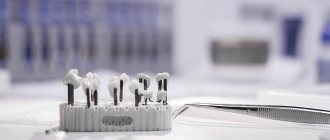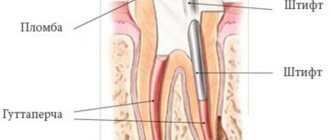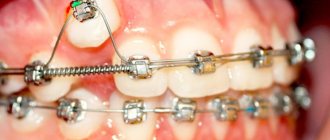Situations when a person needs orthodontic treatment
and
prosthetics
/
implantation
are not uncommon.
Of course, the ideal option, which any dentist will recommend, is to first straighten your teeth with braces, and only after that think about dentures or implants. Prosthetics for malocclusion can lead to the fact that the load on the dentures will be uneven, and some of the crowns and “native” teeth will wear out much faster, and their shelf life will be reduced, not to mention the load on the temporomandibular joint (TMJ) )
.
But it often happens that by the time braces are installed in the patient’s mouth, crowns or implants have already been placed, and then the question “is it possible?” arises quite naturally.
Is it possible to put braces on implants?
- When installing an artificial titanium root in the jawbone, the surgeon tries to fit it organically into the dentition with pinpoint precision, carefully calculating the required position in advance.
- But if at this time the patient’s bite was disturbed and the teeth were in incorrect positions, the implant, of course, will also be positioned incorrectly.
- If you install braces, then natural teeth, which retain the ability to move throughout life, will begin to move under the influence of the traction of the orthodontic arch. But the artificial root can simply come out of the bone as a result of prolonged, constant load.
Therefore, if it is necessary to restore several missing teeth and there is a malocclusion, the patient must be explained that the position of the existing teeth should first be corrected, and then implantation should be carried out. But in some cases, options are possible, especially if there is no need to attach braces to existing implants.
Alternatives
In addition to correcting the bite with crowns, alternative methods are used. Removable or non-removable systems are used. Advanced technologies make it possible to reduce the percentage of surgical interventions prescribed.
The method is selected individually and depends on age, dental condition and other reasons. Ways to correct a bite:
- Braces. Used to eliminate problems in adults, adolescents and children.
The position of the teeth is changed in three directions. Wearing them is not always comfortable. Lingual briquettes are most often used. In this case, the installation is performed on the inner surface of the teeth, which is more invisible. The material of the braces for maximum invisibility is ceramics, artificial sapphires. - Mouthguards. A more aesthetic option than braces is made of transparent plastic. Use polyurethane or silicone. Worn for at least 2 years.
- Trainers. Their use is justified for minor bite problems. This is a type of mouthguard.
- Exercises. Not a self-sufficient tool, they help speed up the correction process together with the use of other devices.
- Surgical intervention. It is used when a tooth needs to be removed to gain a place in a row. The goal is to reduce or completely eliminate imbalances.
In order for your bite to be correct, you need to see a dentist and get your teeth in order. After the examination, an individual strategy for treatment and straightening of teeth closure is selected.
Taking into account modern means, there are practically no age restrictions. The difference is that for children the correction process will be at least twice as fast.
Is it possible to put braces on crowns?
Since the root of a tooth covered with a crown remains alive, it also retains the ability to move in a given direction. But when making a decision, the orthodontist will definitely take into account the material from which the crown is made and check the strength of its fixation.
The patient needs to understand that the adhesion of the braces to artificial materials will be less reliable than to natural enamel. Therefore, most likely, the doctor will suggest installing metal self-ligating braces - not the most aesthetic, but in this case providing the highest strength of fixation. However, during the treatment process you will have to be doubly careful and avoid eating hard, tough and sticky foods to prevent the locks from coming off.
Installation
Fortunately, the presence of dentures and crowns in the mouth is not an absolute contraindication to the installation of braces of any type. However, before starting treatment, the dentist must conduct a thorough examination, take the necessary tests and take an x-ray. Only based on the results of the patient’s examination, the doctor can decide on the advisability of installing braces.
Since correcting a bite using this method takes quite a lot of time, before fixing braces, you should carry out a complete sanitation of the oral cavity, heal existing carious cavities, eliminate pockets of inflammation, etc. Also, sometimes it is necessary to replace previously installed crowns and fillings. If this is not done, serious complications may occur.
Let us note once again that braces can be placed on crowns, but there is a small risk of their deformation or incompatibility of the materials used. This is why a highly qualified orthodontist is so important, who can select the optimal system and install it correctly.
Is it possible to move the teeth on which the bridge rests?
It is possible to normalize the bite in the presence of a bridge prosthesis, but this will require a certain preparatory period.
- To prevent the solid structure from collapsing during orthodontic treatment, it can be cut into separate elements.
- There is another option: the bridge is removed and replaced with temporary plastic crowns during the correction.
During the treatment of patients with crowns and bridges, additional problems may arise. Thus, the surface of the crown will almost certainly change its appearance - it will become rough and darken. Therefore, after removing the braces, it will have to be put in order - polished. A crown removed before treatment cannot be reinstalled, because the position of the teeth will no longer be the same as at the time the impression was taken to make it.
Care instructions
Without proper care of braces and crowns, problems are unlikely to be avoided. Treatment is impossible without observing a number of important rules, which the attending dentist will definitely tell you about before sending your patient home. It is extremely important to brush your teeth daily, morning and evening, and after all meals and sugary drinks.
To maintain hygiene, both classic brushes with bristles of different hardness, as well as single-tuft options and brushes are perfect. You should also purchase a suitable rinse aid to treat the cavity after cleaning. It will not only remove food particles from hard-to-reach places, but also freshen your breath.
A device such as an irrigator has proven itself to be excellent. Additionally, you can purchase dental floss and therapeutic and prophylactic pastes. Braces need to be cleaned from all sides, paying attention to the areas under the clasps and archwire.
previous post
Why get braces?
next entry
Ceramic inlay - microinsert that replaces a filling
As you know, before filling a tooth affected by caries, the doctor first excises its non-viable tissue. Therefore, in case of secondary caries, when the filling has to be re-placed, due to the significant size of the cavity, the tooth is already practically destroyed. The patient is recommended to undergo depulpation and cover it with a crown.
Recurrence of caries occurs due to the lack of proper sealing between the walls of the tooth and the composite filling, which decreases in volume during polymerization. The ceramic inlay is free of this drawback; it is manufactured individually with high precision and therefore fits tightly to the tooth. The ceramic material of the inlay does not shrink and does not change color or shape during use.
Microprosthetics with inlays is performed on teeth whose defects make up up to 30% of the volume of their coronal part, and allows you to create exact copies of teeth with the correct shape of the chewing surface.
The use of mini and micro implants in orthodontics
Are mini-implants a marketing name or really some new technology in dental practice?
In some cases, orthodontic implants are the only way to change a difficult situation for the better, but this is not a new thing. Mini and micro orthodontic implants are the same thing. Regardless of the manufacturer, production method and purpose, they have the same appearance. There is a difference in price, and sometimes very significant.
What is noteworthy is that domestic models, which cost 10 times less than their foreign counterparts, work no worse.
What orthodontic cases require the use of microimplants?
Their use is important when the classic braces system fails. For example, to correct the angular position of teeth or their rotation along the axis.
The orthodontist inserts microimplants about 5 millimeters long into certain areas of the bone (usually between the roots of teeth), and distributes traction to them for movement. After the desired effect is achieved, the rods are carefully removed. They are temporary and never fuse with the bone.
Frequent indications for the installation of orthodontic implants are:
- distal bite (when the upper row of teeth is pushed forward);
- high position of teeth;
- crowded teeth;
- fan-shaped divergence;
- open and deep bite.
Are mini-implants really easier to install than classic ones, like orthodontic implantation?
The procedure for implanting microimplants is less traumatic than the traditional one and takes only a few minutes. The doctor's sequence of actions is as follows:
- The gums are treated with an anesthetic spray.
- An anesthetic injection is given into the treated area.
- Using a bur, a narrow canal is formed in the jaw bone tissue.
- The rod is screwed in.
The upper part of the mini-implant remains above the gingival surface. By attaching springs or chains to the head of the implant, the stable tension required for tooth movement will be created.
Is there a risk of injury to the roots of living teeth when introducing microimplants?
Such a danger exists. During installation, a microimplant may touch the root of one of the teeth between which it is being inserted. However, an experienced doctor always takes x-rays before the procedure, which makes it possible to calculate the location of the rod as accurately as possible.
If contact does occur, the specialist changes the direction of the structure and continues fixation. A damaged root does not require treatment; after a while it will recover on its own.
Which manufacturers' mini-implants are inexpensive and of high quality?
They are all the same, in this case the price is not a measure of quality. All commercially available models provide for fixation into atrophied bone and ensure atraumatic installation. Therefore, the question of choosing a specific company is not fundamental.
The Doctor Levin Center for Private Dentistry uses microimplants from Micerium SpA (Italy) or Conmet (Russia). These are quality products at an affordable price. We do not try to sell our patients expensive orthodontic structures if they have a worthy cheaper alternative that is not inferior in functionality.
How long will a patient have to wear mini implants to achieve the desired results in orthodontic treatment?
The period of use of microimplants depends on the duration of treatment, usually no longer than 6-8 months. After this period has expired, the microimplant can be replaced with another one, and if the bite correction process is completed, the braces along with the rod are removed.
How are temporary micro-rods removed? Is it painful, what remains at the site of the removed implant?
The procedure for removing orthodontic implants is simple. Due to the fact that they do not have the ability to fuse with bone tissue, the latter softens during treatment and the fixation of the rod weakens. Therefore, removing it is quite simple - it can be unscrewed in a matter of seconds with a special screwdriver.
The patient does not feel any discomfort due to the use of a local anesthetic. A small wound will then heal within a few days.
Is it possible to install microimplants during pregnancy?
Microimplantation, like classical implantation, is contraindicated during pregnancy. Firstly, this is a surgical operation that involves the use of anesthesia. Secondly, the preparatory stage for the procedure includes diagnostic methods such as radiography, which cannot be performed on pregnant women.
Are there any contraindications to the use of microimplants and what could be an alternative in such cases?
It is not recommended to use mini-implants in orthodontic treatment if:
- diabetes mellitus;
- mental disorders;
- AIDS;
- diseases of the cardiovascular system;
- endocrine pathologies;
- blood clotting disorders;
- the presence of malignant tumors;
- alcoholism;
- drug addiction.
As an alternative, the following solutions may be offered to such patients:
- creating correct contact between the jaws using intermaxillary rubber rods;
- the use of a complex face bow;
- removal of one or more teeth.
